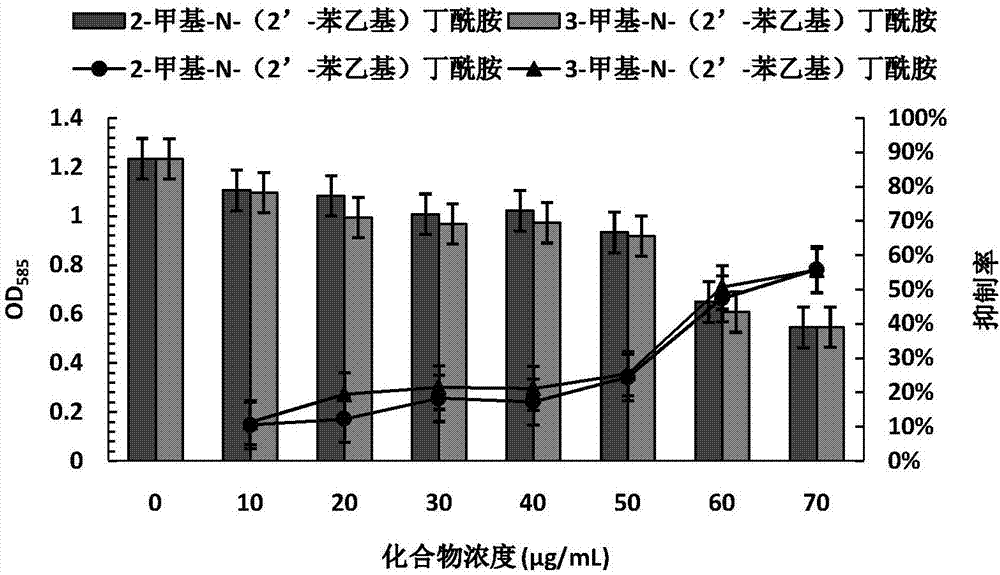Application of amide compounds to preparation of quorum sensing activity inhibitors
A technology of amide compounds and activity inhibitors, which is applied in the application field of amide compounds in the preparation of bacterial quorum sensing activity inhibitors, can solve problems such as drugs that have not yet been seen, and achieve controllable fermentation conditions and reduce purple pigment The effect of simple production and preparation process
- Summary
- Abstract
- Description
- Claims
- Application Information
AI Technical Summary
Problems solved by technology
Method used
Image
Examples
Embodiment 1
[0028] Purification and structure identification of embodiment 1 active compound
[0029] (1) Preparation of crude extract: inoculate Pacific bacillus XC22919 (Oceanobacillus sp.XC22919) into slant medium (ie: LB seawater solid medium: peptone 10g / L, yeast extract 5g / L, NaCl 10g / L, sea salt 33.3g / L, agar 18g / L, the solvent is deionized water, pH 7.4; 121°C, sterilized for 20min), cultivated overnight in a constant temperature incubator at 30°C to obtain slant bacteria; then inoculate the slant bacteria to the seeds Culture medium (that is, LB seawater liquid medium, remove the agar in LB seawater solid medium, and the others are the same), in a constant temperature shaker at 30°C, vibrate at 180rpm and cultivate overnight to obtain seed liquid; The inoculum was inoculated into LB seawater liquid medium (peptone 10g / L, yeast extract 5g / L, NaCl 10g / L, sea salt 33.3g / L, solvent was deionized water, pH 7.4; 121°C, sterilized for 20min) Fermentation culture was carried out, and sh...
Embodiment 2
[0041] Example 2 Test of two kinds of amide compounds inhibiting quorum sensing activity of P. violaceum CV026
[0042] (1) Experimental method: inoculate CV026 containing exogenous signal molecule Chromobacterium violaceum (given from Professor David C. Rowley, University of Rhode Island, USA) into LB liquid medium, and culture overnight at 30°C to obtain Violet bacteria CV026 bacteria liquid.
[0043] After diluting the violaceum bacteria CV026 liquid with fresh LB liquid medium at a volume ratio of 1:100, 10 mL per bottle. The monomer compound 2-methyl-N -(2'-phenylethyl)butanamide (added as a 50 mg / mL solution in methanol) and 3-methyl-N-(2'-phenylethyl)butanamide (added as a 50 mg / mL solution in methanol ), with methanol as a negative control. Put it on a shaker at 30°C and 150rpm for about 18h, take 1mL of the bacterial solution, centrifuge for the first time at 12000rpm for 10min, discard the supernatant, add 1mLDMSO, vortex and shake to completely dissolve violacein...
Embodiment 3
[0045] Example 3 Effects of two kinds of amide compounds on the growth of Pseudomonas aeruginosa PAO1 and the output of pyocyanin
[0046] (1) Experimental method: Pseudomonas aeruginosa (Pseudomonas aeruginosa) PAO1 was inoculated into LB medium, cultured overnight at 37° C. to obtain Pseudomonas aeruginosa PAO1 bacterial liquid.
[0047] Pseudomonas aeruginosa PAO1 bacteria liquid was used fresh PB liquid culture medium (peptone 20g / L, magnesium chloride 1.4g / L, potassium sulfate 10g / L, solvent was deionized water, pH natural; 121 ℃, sterilization 20min) with After dilution by volume ratio of 1:100, each bottle is 10mL. Add monomer compound 2-methyl-N-(2'-phenylethyl ) butanamide (added in the form of a 50 mg / mL methanol solution) and 3-methyl-N-(2'-phenylethyl) butanamide (added in the form of a 50 mg / mL methanol solution), with methanol as a negative control. Place it on a shaker at 37°C and 150rpm for about 24h. Take 6mL of bacterial liquid, add 3mL of chloroform for e...
PUM
 Login to View More
Login to View More Abstract
Description
Claims
Application Information
 Login to View More
Login to View More - R&D
- Intellectual Property
- Life Sciences
- Materials
- Tech Scout
- Unparalleled Data Quality
- Higher Quality Content
- 60% Fewer Hallucinations
Browse by: Latest US Patents, China's latest patents, Technical Efficacy Thesaurus, Application Domain, Technology Topic, Popular Technical Reports.
© 2025 PatSnap. All rights reserved.Legal|Privacy policy|Modern Slavery Act Transparency Statement|Sitemap|About US| Contact US: help@patsnap.com



